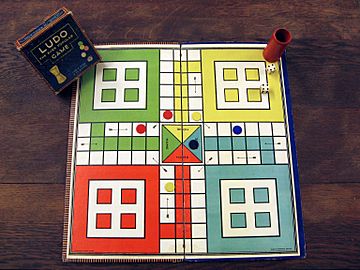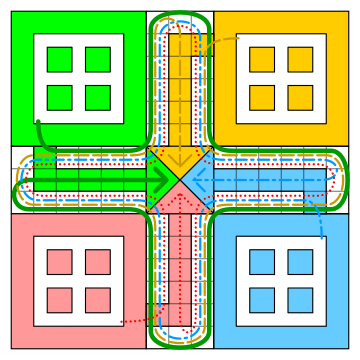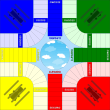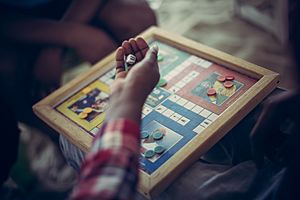Ludo facts for kids
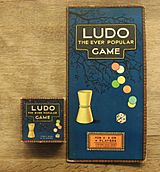
One of the first editions of Ludo
|
|
| Years active | Since c. 1896 |
|---|---|
| Genre(s) | Board game Race game Dice game |
| Players | 2–4 |
| Playing time | < 90 min |
| Random chance | High (dice rolling) |
| Skill(s) required | Strategy, tactics, counting, probability |
Ludo is a super fun board game for two to four players. It's a strategy game where you race your four playing pieces, called tokens, from start to finish. You move your tokens based on what you roll on a single die.
Ludo is part of a family of games called "cross and circle" games. It actually comes from an old Indian game called Pachisi. Ludo and its many versions are popular all over the world, known by different names!
Contents
Ludo: A Fun Board Game
The Story of Ludo
Ancient Origins in India
The game of Pachisi began in India way back in the 6th century CE. We know this because pictures of game boards have been found in the Ellora Caves in India.
An old Indian story, the Mahabharata, even talks about a game like Pachisi. In the story, a character named Shakuni uses special dice to win against the Pandavas. The Pandavas lose everything, including their wife Draupadi. But Draupadi threatens to curse the whole kingdom. So, the king promises to give the Pandavas back everything they lost in the game.
In ancient India, this game was also known as Chaupar.
Ludo Comes to England
Pachisi was changed a bit to use a normal six-sided die and a dice cup. It was then given the name "Ludo" and officially registered in England in 1896. The Royal Navy even made their own version of Ludo, which they called Uckers.
How the Ludo Board Looks
The Ludo board usually has bright yellow, green, red, and blue areas. Each player picks a color and gets four tokens of that color.
The board is shaped like a square with a cross in the middle. Each arm of the cross has three rows of squares. Most of these rows have five colored squares. These are like a player's "home" path. There's also a sixth colored square that's a player's starting spot.
In the very center of the board is a big finishing area. It often looks like colored triangles that point to the finish line.
Playing Ludo: The Rules
Getting Started
Two, three, or four people can play Ludo. No one plays in teams. At the start, all four of your tokens are in your "yard." This is one of the big colored corner areas on the board.
To get a token onto the board, you must roll a six. Once you roll a six, you can place one token on your starting square. You can also move a token that's already on the board six spaces. If you don't have any tokens on the board and don't roll a six, your turn ends.
The player who rolls the highest number starts the game. Then, players take turns moving clockwise around the board.
Moving Your Pieces
Once you have tokens on the board, you choose one and move it forward. You move the number of squares shown on your die roll.
If your token lands on a square where an opponent's token is, you "capture" their token! That opponent's token goes back to their yard. They will need to roll another six to get it back into play.
If two of your own tokens land on the same spot, they create a "block." An opponent cannot land on a block. If an opponent's token would land on your block, it must go back to their yard.
Special Rules and Winning
If you roll a six, you get an extra turn! If you roll another six on your bonus turn, you get yet another bonus roll. But if you roll a third six in a row, you can't move any pieces. Your turn ends right away, and it's the next player's turn.
Your home column squares are always safe. Opponents cannot enter these squares. Once your token reaches the square just before your home column, it moves up that column. To get a token into the final finishing square, you need to roll the exact number.
The first player to get all four of their tokens into the home triangle wins the game! Sometimes, players keep playing to see who finishes second, third, and fourth.
Different Ways to Play Ludo
Ludo Around the World
Ludo has many different names and versions around the world:
- Uckers: A British version.
- Pachisi: The original Indian game.
- Fia: Played in Sweden.
- Eile mit Weile (Haste makes Pace): A Swiss version.
- Cờ cá ngựa: From Vietnam.
- Parchís: Played in Spain.
- Parqués: A Colombian game with special rules like "Vuelta obligada" (mandatory restart) and "Cielo robado" (stolen heaven).
Mensch ärgere dich nicht
This German game, meaning "Man, Don't Get Angry," started in 1914. It has similar names in many other languages:
- Mens Erger Je Niet (Dutch)
- Non t'arrabbiare (Italian)
- Člověče, nezlob se (Czech)
- Kızma Birader (Turkish)
Other Variants
- Aeroplane chess: A Chinese game like Ludo, but with airplanes as tokens. It has extra features like jumps and shortcuts.
- Tock: A Canadian game played with playing cards instead of dice.
- Riču-Raču: The Latvian version. It has a bigger board and special rules for rolling a one or a six.
How Ludo Rules Can Change

Rules for Ludo can be different depending on where you play:
- In India, some Ludo boards have "safe squares" marked with a star. Also, people often play with two dice. Rolling a one can also get a token into play.
- In Pakistan, some versions use two dice and allow tokens to move backward!
- Some "house rules" (rules families make up) let you get your first piece out on any roll, or on a one or a six. Some even let you try to roll a six three times.
- Sometimes, if your token lands on the same spot as another of your tokens, the moved token must go to the space before it.
- In Denmark, the board has "globe" spaces that are safe. Your pieces cannot be captured there.
- In Vietnam, the game is called "Cờ cá ngựa" and uses horse tokens. Rolling a one is just as good as rolling a six. Also, to move up the home column, you need to roll the exact number for each square.
African Rules
In some parts of Africa, like Nigeria and South Africa, there are unique rules:
- A "doubled block" (two of your tokens together) can block your own trailing pieces.
- If players sitting across from each other are partners, they can swap numbers they roll!
- There are extra safety squares on the board, like "castle squares" in Pachisi.
- If your piece lands on an opponent's piece, their piece goes back to their yard. But your piece also goes back to your home square!
- You might not be able to move your first piece into the home column until you've captured at least one opponent's piece.
- If you capture an opponent's piece, you get a bonus roll. If you capture another piece on that bonus roll, you get another bonus roll!
See also
 In Spanish: Ludo para niños
In Spanish: Ludo para niños


